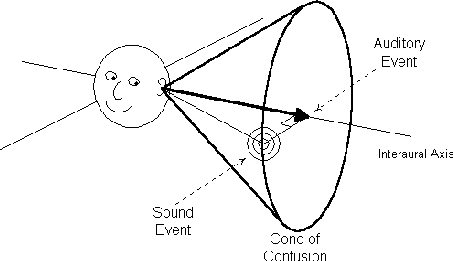
Next: The power of motion Up: 11.3 Auditory Perception Previous: Monaural cues Contents Index
If both ears become involved, then a binaural cue for localization results. The simplest case is the interaural level difference (ILD), which is the difference in sound magnitude as heard by each ear. For example, one ear may be facing a sound source, while the other is in the acoustic shadow (the shadow caused by an object in front of a sound source is similar the shadow from a light source). The closer ear would receive a much stronger vibration than the other.
Another binaural cue is interaural time difference (ITD), which is closely related to the TDOA sensing approach described in Section 9.3. The distance between the two ears is approximately ![]() cm, which results in different arrival times of the sound from a source. Note that sound travels
cm, which results in different arrival times of the sound from a source. Note that sound travels ![]() cm in about
cm in about ![]() ms, which means that surprisingly small differences are used for localization.
ms, which means that surprisingly small differences are used for localization.
 |
Suppose that the brain measures the difference in arrival times as ![]() ms. What is the set of possible places where the source could have originated? This can be solved by setting up algebraic equations, which results in a conical surface known as a hyperboloid. If it is not known which sound came first, then the set of possible places is a hyperboloid of two disjoint sheets. Since the brain knows which one came first, the two sheets are narrowed down to one hyperboloid sheet, which is called the cone of confusion; see Figure 11.11 (in most cases, it approximately looks like a cone, even though it is hyperboloid). Uncertainty within this cone can be partly resolved, however, by using the distortions of the pinna.
ms. What is the set of possible places where the source could have originated? This can be solved by setting up algebraic equations, which results in a conical surface known as a hyperboloid. If it is not known which sound came first, then the set of possible places is a hyperboloid of two disjoint sheets. Since the brain knows which one came first, the two sheets are narrowed down to one hyperboloid sheet, which is called the cone of confusion; see Figure 11.11 (in most cases, it approximately looks like a cone, even though it is hyperboloid). Uncertainty within this cone can be partly resolved, however, by using the distortions of the pinna.
Steven M LaValle 2020-01-06